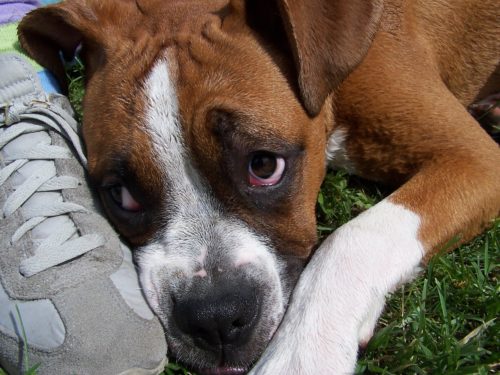When you first spot Cherry Eye in your dog it can be alarming. The bright red mass protruding from your pet’s eye is a serious condition that can cause permanent damage to the eye and should be treated as soon as possible.
While Cherry Eye can be seen in any breed, it most commonly affects Cocker Spaniels, Bulldogs, Boston Terriers, Beagles, Bloodhounds, Lhasa Apsos, Shih Tzus, and other brachycephalic breeds (dogs with “squished” faces and short limbs). As a result, owners of these breeds should keep a close watch for the signs of Cherry Eye.
What is Cherry Eye?
Cherry Eye, a colloquial term, is formally known as a prolapse of the third eyelid gland. Many mammals, including dogs, have a third eyelid located inside the lower eyelid which serves as additional protection for the eye, particularly during hunting or fighting.
This third eyelid also contains a gland that produces a significant portion of the eye’s protective tear film. This gland prolapsing, or popping out, is what we know as Cherry Eye.
What Causes Cherry Eye in Dogs?

The exact cause of Cherry Eye is, unfortunately, unknown. However, given the prevalence in certain breeds there is thought to be a genetic component which may cause a weakening in the fibrous attachment that holds the gland in place and allows it to prolapse easily. This congenital weakness in the gland’s attachment is the only real cause of Cherry Eye and, sadly, cannot be prevented.
Other causes of a mass on the eye which may give the appearance of Cherry Eye include everted, or inside out, cartilage in the third eyelid, abnormal cells in the third eyelid, or a prolapse of fat in your dog’s eye. Your vet can help to determine if a mass on your dog’s eye is the result of one of these other causes or is, in fact, Cherry Eye.
Signs of Cherry Eye in Dogs
While Cherry Eye may seem obvious to spot, there are some nuances that might make it difficult. The prolapsed gland will appear as a red swollen mass on the lower eyelid near the muzzle or nose. The mass could be large and cover a significant portion of the eye without fading, making it very easy to recognize.
However, it may present itself as small and appear only periodically – making it much more difficult to identify. At any sign of Cherry Eye, notify your vet of the symptoms for further evaluation. The gland, which produces up to 50% aqueous portion of the tear film, is important to the health of the eye and if left unattended, may result in dry eye that can lead to serious vision impairment.
Treating Cherry Eye in Dogs

Treatment for Cherry Eye will depend on the severity of the case and is aimed at reducing the risk of further complications or permanent damage to the eye. Mild cases may be addressed with topical anti-inflammatory drugs which can be effective in reducing the swelling of the gland.
Moderate to severe cases, on the other hand, will require surgical intervention. In surgery, an attempt is made to replace the gland in its original position. However, severe or chronic cases may require a complete removal of the gland from the eyelid.
In most surgical cases that do not require removal, the gland will return to normal within a few weeks. Re-prolapse is a possibility after surgery and your pet should be monitored closely. In addition, those dogs which experience prolapse in one eye are likely to develop it in the other eye.
Your vet will discuss treatment options and work with you to determine the appropriate course of action for your dog’s condition.
While Cherry Eye cannot be directly prevented, it is important to look for signs of prolapse in your pet. This is especially crucial for those owners of breeds prone to developing a prolapse. Bringing Cherry Eye to the attention of your vet sooner rather than later can help mitigate or prevent any damage to the cornea and your dog’s eyesight long term.
If you are able to prevent the gland from developing into a complete prolapse, you may be able to reduce the recurrence of this canine eye disease.




